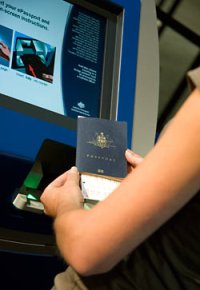Customs to finally deliver SmartGate

After seven years testing border control biometrics, Australian Customs Service says every Australian international airport will be equipped with SmartGate by June 2009.

SmartGate kiosk
(Credit: Customs)
SmartGate trials using facial recognition biometrics for border control began in 2002 under a program limited to Qantas staff. Since then, the system has been deployed at Brisbane, Cairns and most recently Melbourne, for Australians holding e-passports.
"Melbourne has gone live. As of last Monday, we've had more than 5,000 successful transactions," a senior Customs spokesperson told ZDNet.com.au.
The system, which Customs was granted $61.7 million over four years to complete, is primarily to cut passenger processing time when entering Australia. Customs claims that the number of travellers coming to Australia through its airports is increasing at a rate of five per cent annually, and is expected to reach 9 million by 2016.
"There's a major increase in travellers coming across the border and we only have a limited number of space we can facilitate them within. We can't just add hundreds of extra Customs officers and primer line modules [booths]," the spokesperson said.
An earlier version of SmartGate was trialled to assess the viability of biometric technology that was available at the time. Qantas staff that enrolled to use that system complained that it did not save them any time.
"It was something Customs developed itself where you just place your passport in front of a reader and look at the camera. It didn't account for queuing and streamlining back-end processes. It was literally a trial to test biometrics," the spokesperson said.
SmartGate
(Credit: Customs)
The SmartGate system that most Australians will use, come June 2009, will involve two steps: passengers first place e-passports on a scanner at a kiosk, which unlocks and reads data stored on the chip embedded in the middle page of the e-passport. After answering standard declarations, such as where the traveller has been, a ticket is issued. The passenger then proceeds to a scanning station where data associated with the ticket is cross-checked against biometric data collected from the person.
The reason for SmartGate's long delivery horizon has been the availability of e-passports — which are critical to the system's operation but only issued when older passports reach their 10-year expiry — and long-term expansion works at airports, according to the spokesperson.
"The airports are trying to rebuild to cater for the A380s and to deal with increasing numbers of travellers. That poses difficulties for our implementation schedule," the spokesperson said.
SmartGate won't automate all Customs' processing work however, with the only other country able to use it being New Zealand. Three Customs e-passport readers have been installed at Auckland international airport, allowing its citizens to complete the first step prior to arrival.
DFAT will determine what other countries' citizens will be able to use SmartGate, but no plans have been revealed yet, the spokesperson said.